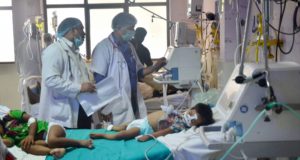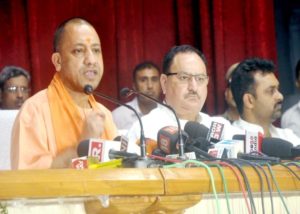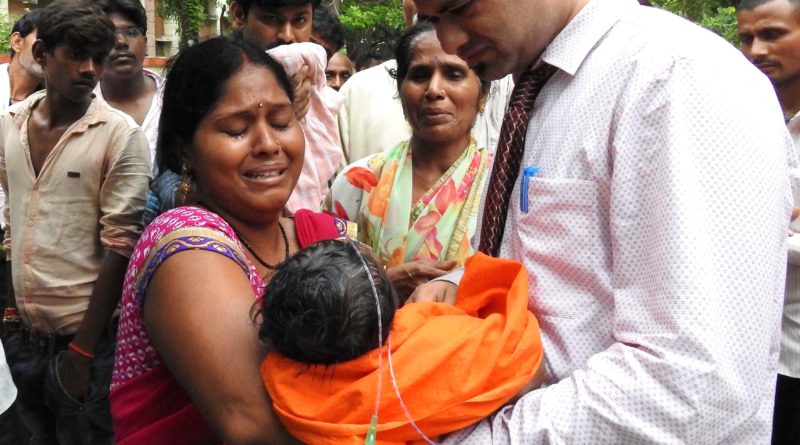Collapse of the System
The Gorakhpur tragedy where more than 70 children perished has shocked the nation. While the state government is trying to cope with its tragic aftermath, it needs to restore sanity and order to the ailing state of the state’s health infrastructure that always leaves rooms for such disasters to happen
By Amresh Kumar Tiwary
 Tears rolled down the eyes of Abdul Razak, who hails from Imambara, a famous place in Gorakhpur, when he saw his nine-year-old son Wahid motionless due to gross negligence and incorrigible misconduct in Gorakhpur’s Baba Raghav Das (BRD) Medical College and Hospital where deaths of over 72 children took place.
Tears rolled down the eyes of Abdul Razak, who hails from Imambara, a famous place in Gorakhpur, when he saw his nine-year-old son Wahid motionless due to gross negligence and incorrigible misconduct in Gorakhpur’s Baba Raghav Das (BRD) Medical College and Hospital where deaths of over 72 children took place.
Like Abdul Razak several parents lost their lovable kids due to oxygen shortage. They want immediate cognizance of the crime and punishment to culprits. They lament the present system and demand a probe against persons who are responsible for this tragedy of such unprecedented proportions.
BRD Medical College and Hospital is the biggest hospital in Gorakhpur, which is also the hometown and parliamentary constituency of Uttar Pradesh’s Chief Minister Yogi Adityanath.The recent tragedy in BRD shook the entire government machinery. Everybody is shocked and mourns the heartbreaking deaths of innocent children.
The unfortunate deaths of children have been blamed on infections and possible disruption in oxygen supply in the paediatrics ward. The oxygen supply had been stopped by the vendor after the hospital had defaulted on the payment. The hospital had been functioning without any oxygen cylinders for two hours. But the hospital and district administration have rejected oxygen shortage as the reason. The government denied that the deaths had been caused due to shortage of oxygen since the hospital had made arrangements.
According to Gorakhpur district administration claims, no death took place due to shortage of oxygen supply, it was due to different medical reasons.As far as the complaint regarding non-payment of dues to the company supplying the oxygen is concerned, it is a matter of inquiry.
As per the government version, there was existing alternative arrangement of 50 oxygen cylinders which was used, so there was no shortage of oxygen. Uttar Pradesh Health Minister Siddharth Nath Singh said that if anyone was found guilty, he would be made accountable.
What opposition blames
Many opposition leaders like that of Congress and Samajwadi Party including Leader of Opposition in Rajya Sabha Ghulam Nabi Azad, UP Congress president Raj Babbar, Rajya Sabha members Pramod Tiwari and Sanjay Singh visited the medical college and met families of the dead children.Former Chief Minister and SP chief Akhilesh Yadav held the state government responsible for the deaths and demanded strict action and compensation of Rs 20 lakh to the kin of each child.
 What CM says
What CM says
Chief Minister Yogi Adityanath during his visit to the hospital promised exemplary punishment for the guilty. Union minister JP Nadda, who had accompanied the Chief Minister, ruled out a separate investigation by the Centre, saying the state government had his ministry’s “full support”.
The Chief Minister has said it would be heinous if the children had died because of a disruption in oxygen supply. He also said the government had cleared the payment for the oxygen vendor on August 7. The hospital, however, had not released the funds till August 11.
BJP chief Amit Shah said the recent death incidence in hospital was a tragedy that happened at some level, but no one could deny the government’s aim to help. He dismissed the demands raised by opposition parties that Uttar Pradesh Chief Minister Yogi Adityanath must resign.
The Yogi Adityanath government has emphatically denied any deaths because of the oxygen shortage, saying the disruption lasted only two hours and oxygen was arranged from other sources.
Chief Minister Adityanath has ordered an investigation and has promised “standard-setting” punishment for anyone found guilty of negligence. The hospital’s medical chief Dr Rajeev Mishra and head paediatrician Dr Kafeel Khan have been suspended.
Dr K K Aggarwal, National President, Indian Medical Association, has highly objected to the suspension of the. “Why the principal of Medical College has been suspended, why not Chief Secretary and other concerned officers have been jailed. It is really anarchy. We as medical practitioners cannot be subjected to the blame game.It needs to be probed”, he asked vehemently. This move was criticized by the doctors at Delhi Medical Association (DMA) too.
Civic Apathy
Inside the hospital wards, where the media was allowed the condition was found to be very unhygienic. Less than 50 metres from the ICU, where many children were admitted with encephalitis, there were puddles of water where mosquitoes were breeding. The wards were untidy and dusty. In some cases, even medicine bottles had been left open.
Samajwadi Party (SP) president Akhilesh Yadav alleged that the BJP government was trying to cover up the facts in the incident and dispatched a six-member delegation led by Leader of Opposition in UP, Ram Govind Chaudhary, to the hospital to take stock of the ground situation. They would submit their report to the SP chief. The former CM alleged that the kin of the dead were handed over the bodies and chased away. A post-mortem was also not conducted and the admit cards were also made to vanish.
BSP chief Mayawati demanded a high-level probe into the incident and suggested that CM Adityanath should exercise his “discretion” and sack his Health Minister as the deaths were a case of “criminal negligence.”
“No amount of condemnation of the BJP government is enough for this horrific incident,”Mayawati said, adding that it raised “100 questions” on the “potential” of the Yogi Adityanath government.
If the data available with the hospital is to be believed of the first 30 deaths that occurred on the very first day, only five were due to acute encephalitis syndrome or acute encephalitis syndrome (AES); one was due to hepatic encephalopathy, which is related to AES. The other deaths were of terminally ill newborns.Some of them suffered from diseases such as pneumonia, sepsis, and swine flu while others were preterm babies in a critical condition. Newborn babies don’t suffer from AES. The list of deceased shows that only five children died of AES and one due to hepatic encephalopathy.
According to Dr Arvind Garg, senior consultant, pediatrics, Apollo Hospital, Noida, “As per the list, all other babies were newborns who were apparently in need of expert emergency care services. Such cases are very critical and need continuous supply of ventilation. Data shows that the hospital’s record in curing patients admitted to its paediatric and intensive care units isn’t good.”
Till July 2017, the total number of admissions to the pediatrics department was 3,878, of which 596 patients died. The figures for the neonatal intensive care unit (newborns) arouse even more concern—of the total 2,386 admissions, 931 died.
Uttar Pradesh has the worst infant mortality rate in the country of 78 (per 1,000 live births) according to the National Family Health Survey- IV (2015-16). The national average is 41.
Ailing Health
In light of the deaths at BRD Medical College, child health specialists have pointed to the importance of strengthening emergency medical services in the state.
According to Dr Soumya Swaminathan, secretary, Department Of Health Research, Union health ministry, and director general at the Indian Council of Medical Research (ICMR), “We had conducted a special workshop on emergency care at BRD Medical College. Intensive care management of sick patients and ventilator management is an expertise which is lacking in the state. We recently conducted a workshop at the hospital and trained doctors. We involved many private experts and doctors from government hospitals from Delhi. So many patients cannot die of encephalitis in two days. In fact, when ICMR came up with a report under National Japanese Encephalitis Control Programme in Uttar Pradesh, especially in Gorakhpur, only 5 to 10% of cases were of Japanese Encephalitis. With high death rate of infants, it is apparent that intensive care units are poorly managed and they don’t have trained staff.”
In general, public health programmes in Uttar Pradesh are in a sorry state. In the last 15 years, the population of the state has increased by 25% but the number of public health centres, the core health facilities of the government, has actually fallen by 8%.
BRD Medical College hospital is the only hospital in a 300 sq km stretch of the region with decent facilities to treat encephalitis and similar infectious diseases. This hospital treats patients coming from Gonda, Basti, terai regions Nepal and eastern districts of Bihar. These are the districts where cleanliness and sanitation have been a major problem. In fact, in the Swachh Bharat Survey 2017, Gonda was declared as the dirtiest district in India.
Menace of Encephalitis
The incidence of encephalitis in these districts is very high particularly among children below 8-10 years of age. The Japanese Encephalitis and Acute Encephalitis Syndrome are caused by mosquito bites of Culex vishnui and Culex tritaeniorhynchus. Filth is home to these species of mosquito. Every year, monsoon season is the worst season for children in Gorakhpur.
Encephalitis is an inflammation of the brain which can cause fever, headache, confusion, seizures, and, in some cases, death.Fewer than 1 percent of people infected with the virus develop symptoms. However, according to the World Health Organization (WHO), it is fatal for 30 percent of those who do develop symptoms.
AES is characterized by an acute onset of fever and clinical neurological manifestation that includes mental confusion, disorientation, delirium, or coma. Viruses have been mainly attributed to be the cause of AES in India although other sources such as bacteria, fungus, parasites, spirochetes, chemical, and toxins have been reported over the past few decades.
Apart from viral encephalitis, severe form of leptospirosis and toxoplasmosis can cause AES. The causative agent of AES varies with season and geographical location, and predominantly affects population below 15 years.
Keeping in mind the wide range of causal agents and the rapid rate of neurological impairment due to pathogenesis, clinicians face the challenge of a small window period between diagnosis and treatment. The present report is based on results obtained after reviewing various surveillance and outbreak investigations illustrating how the perspective of AES has changed in India over the years.
AES in India
Several government initiatives have been undertaken to educate and improve the hygiene of people living in the Japanese encephalitis (JE) endemic zones. Government and non-government organizations have been instrumental in providing proper nutrition to the AES-affected population as most of the affected people belong to the lower economic strata of the society. There have been initiatives to help the people residing in the endemic zones for alternative professions such as giving up pig-rearing since pigs are the primary host for JE viruses. Special schools have been set up to help children challenged by clinical sequelae of JE infection
AES was coined way back in 2008 by the World Health Organization to streamline the surveillance and research of AES in India. Over the years, the scenario of AES in India has improved significantly in terms of research and health care facilities. Albeit the development of vaccine against JE and minocycline is under the clinical trials, AES cases in India have not restricted itself to the JE aetiology. This is the biggest challenge clinicians in the field are facing.
Records show that at least 114 children have died this year in Gorakhpur due to encephalitis, which has claimed around 25,000 lives in the last four decades.
What Doctors Say on JE
Dr H P Singh, Senior Child Specialist, Mother & Child Care, Vaishali (Ghaziabad), said, “A person with Japanese encephalitis will probably have no symptoms at all, but if there are symptoms, they will appear 5 to 15 days after being infected. A person with a mild infection may have only a fever and a headache, but in more severe cases, symptoms can develop quickly.
There may be a headache, high fever, tremors, nausea, vomiting, stiff neck, and spastic paralysis. Signs of altered mental status include stupor, disorientation, and coma. Children may have convulsions. There may be swelling of the testicles.
If the brain is involved, life-long neurological defects can result, such as deafness, uncontrollable emotions, and weakness on one side of the body. The chance of survival varies, but children are most at risk.
According to Dr Sarvesh S Joshi, Senior Child Specialist and Secretary, Jaipur Medical Association, Jaipur, “Mosquitoes become infected by feeding on wild birds and domestic pigs that have been infected with the virus. The mosquitoes then pass the virus to humans and animals. Birds and other animals cannot transmit the infection to humans. Only infected mosquitoes can pass it on.The mosquitoes mainly live in agricultural and rural areas. Their larvae breed in pools of water, for example, flooded rice fields.
To diagnose Japanese encephalitis, the doctor will take into account the patient’s symptoms, where they live, and anywhere they have been visiting. This can help to determine the likelihood of having the disease. If they suspect encephalitis, the patient will undergo tests such as a computed tomography (CT) scan or magnetic resonance image (MRI) of the brain.
A lumbar puncture or spinal tap may be used to draw fluid from the spine. The results can show which virus
is causing the encephalitis. Immunofluorescence tests can detect human antibodies. The antibodies show up after being tagged with a fluorescent chemical.
Treatment and prevention of Japanese Encephalitis
There is no treatment or cure for Japanese encephalitis, but there is a safe and effective vaccine that can prevent infection. Travelers should take precautions in areas where Japanese encephalitis is endemic. The vaccine is recommended for people traveling to areas where the disease is endemic, for those on short-term trips lasting less than a month, for people visiting areas where there is an outbreak, and for those participating in outdoor activities.
Once a person has the disease, treatment can only relieve the symptoms. Antibiotics are not effective against viruses, and no effective anti-viral drugs have been discovered. People who spend time outdoors in rural areas should use protective clothing, bed nets, and repellents, and they should sleep in air-conditioned or well-screened rooms.
A person who is new to an area of prevalence does not usually have a natural immunity to the Japanese encephalitis virus. This means that travelers of all ages are more vulnerable to infection than those who have always lived in an area where the disease is found.
In the case of an outbreak, people who live in affected communities should remove pools of standing water, where mosquitoes can breed, and they should use an insect repellant. The most effective insect repellants contain a chemical called diet.
Gorakhpur: In the Clutches of Encephalitis
According to government official records, between January last year and first week of September, 920 patients of encephalitis were admitted to the BRD Medical College hospital. But, this is not the story of a singular isolated year. It is being repeated every year in Gorakhpur since 1978.
This year, 114 encephalitis deaths have been reported till now. Gorakhpur has been in the grip of JE and AES for four decades. Both kinds of encephalitis are viral infections that affect the brain, lead to coma and cause death. At times survivors are left with serious disabilities – mental and physical.
Records show that hundreds die every year in eastern UP due to encephalitis. Gorakhpur is the epicentre of encephalitis-induced deaths. According to official figures, around 25,000 children have died since 1978 due to the two types of encephalitis. And, these are only recorded deaths. Independent figures put the toll around 50,000 as many kids die without reaching hospital.
The Yogi Adityanath government launched a massive anti-encephalitis vaccination programme this year. But, the results may take some time to yield desirable results.
The children’s deaths have a history which began in India with the first report of AES death in the then Madras Presidency in 1956. When it seemed that the viral outbreak had been contained, West Bengal shocked the country in 1973 when around 300 deaths took place in Burdwan and Bankura districts. By 1978, Uttar Pradesh came under attack from the encephalitis viruses. But, the encephalitis threat grabbed attention only in 2005 when 1,344 of 5,737 affected children were killed across Uttar Pradesh. In 2007, a vaccination programme was launched with drugs imported from China. The drive achieved success in many states but somehow Gorakhpur and surrounding areas continued to stay in the grip of encephalitis.
Eastern Uttar Pradesh, where Gorakhpur is located, continues to be one of the most backward areas of the country. Poverty and poor health services go hand in hand in the region. The government or charity hospitals are overburdened. Still, the government authorities cannot be absolved of the serious neglect that has been unable to prevent the deaths of children due to various reasons year after year.

